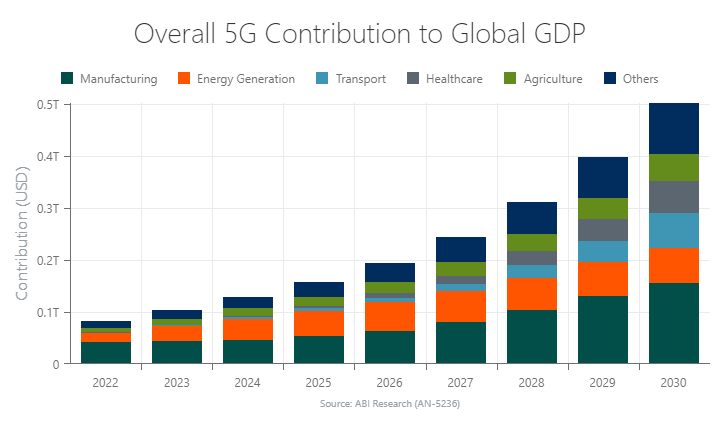The modern enterprise faces significant macroeconomic challenges, with high inflation, rising energy and production costs, and widespread labor shortages affecting operations. To overcome these challenges, enterprises are further digitizing, taking advantage of everything from Augmented Reality (AR) to the Internet of Things (IoT). These high-bandwidth applications require a formidable connectivity backbone, making 5G deployments a key enabler of digitization. 5G promises big connectivity upgrades for enterprises, supporting Enhanced Mobile Broadband (eMBB), Enhanced Ultra-Reliable Low Latency Communication (eURLLC), and Massive Machine-Type Communication (mMTC).
Considering this backdrop, ABI Research recently analyzed the impact of 5G on the global economy and its contribution to the Gross Domestic Product (GDP). Our findings indicate that, by 2030, the overall 5G contribution to the global economy will reach more than US$508 billion, as depicted in the chart below. This post will pinpoint where these economic benefits originate in the enterprise sector.

5G Supports Automation
As enterprises deal with lingering staffing shortages due to the COVID-19 pandemic, automation is seen as essential to staying competitive. 5G networks are important facilitators, as they achieve automated outcomes that are impossible with legacy connectivity protocols.
By 2030, ABI Research expects 5G-supported automation to contribute US$114 billion to the global economy. This 5G contribution is mainly a result of the automation and digitization of voice, the connected worker, and other critical use cases in industrial work settings. Notable examples include large-scale deployments of AR/VR, robotics, and asset tracking.
ABI Research concludes that most of the economic advantages of 5G-supported automation will stem from highly hazardous industries. The manufacturing, energy generation & natural resource extraction (including mining, as well as oil & gas), agriculture, and transportation (including airports) sectors will gain significant revenue boosts from automation, as enterprises aim to increase throughput, cut labor costs, and improve workplace safety.
However, the stadiums and event locations sector is a huge beneficiary of 5G-based automation as well. The adoption of 5G and automation in this sector is due to high demand for content creation and a lack of adequate staffing. These use cases will account for about a fourth of economic attribution from 5G-based automation throughout the decade.
With eMBB capabilities, 5G can also support transmitting large data files, such as video footage. That way, industrial firms can further automate their operations. To summarize these findings, 5G-supported automation reduces enterprises’ reliance on human labor. This equates to reduced labor expenses, operational resilience during labor shortages, and fewer workplace injuries/fatalities. These three business outcomes all bring positive implications for global economic performance.
Efficiency Enhancements
5G also benefits the economy through efficiency enhancements, notably in the manufacturing sector. For example, in typical Wi-Fi-enabled mobility use cases such as Automated Guided Vehicles (AGVs) or Autonomous Mobile Robots (AMRs), latencies can be high and unpredictable, when signals are transferred from one access point to the other. As a result, the AGVs and AMRs must adjust to slower speeds, hindering productivity. 5G provides what is often referred to as “robust handovers” that allow latencies to be constant when signals are transmitted from one access point to the other. These improvements in network efficiency allow AGVs and AMRs to sustain optimal speeds. ABI Research reports that the value of efficiency enhancements powered by 5G will be worth US$207 billion in the manufacturing sector alone by 2030.
Another advantage of 5G extends to the world of smart traffic monitoring. With return-to-office policies on the rise, the bottlenecks associated with traffic backups could potentially exacerbate as more commuters will be on the road. 5G is the connectivity backbone of adaptive traffic lights that optimize signals based on sensor technologies. When fewer people are late for work, this equates to less economic impact due to loss of productivity. This 5G use case also benefits logistics and delivery services, as delivery windows can be met in a more timely fashion. Smart traffic monitoring also can reduce vehicular accidents, further increasing the economic efficiency of a society.
Quality Improvements
The global economy will benefit from the productivity gains provided by 5G-backed quality improvements. In a production plant, for example, 5G facilitates cloud-based quality control of manufactured goods. This minimizes the number of faulty products that get shipped out and, consequently, are returned.
Supply chain operators can also use 5G to better monitor logistics operations. This reduces the frequency of false loading operations, which results in lower costs to course correct.
By 2030, ABI Research forecasts that 5G will contribute US$132 billion to global economic output via quality improvements. However, the smart healthcare space is where the biggest effect occurs. By enabling smart diagnostics and remote care operations, 5G makes healthcare services more accessible to patients. The advantage here is that this will bring down the number of preventable medical interventions or even fatalities, which is beneficial to society and keeps workforces filled.
Introducing Our 5G and Macroeconomics Research Deliverables
Enterprises have a very diverse set of cellular network Key Performance Indicators (KPIs) and legacy technology usage. This makes supporting digitization efforts a little more challenging for Communication Service Providers (CSPs), infrastructure vendors, cloud hyperscalers, and System Integrators (SIs). ABI Research provides strategic recommendations for these vendors in its 5G Impact on the Global Economy and Contribution to the GDP research report. Download the report today to learn more.
This content is part of our 5G and Macroeconomics Research Spotlight.



